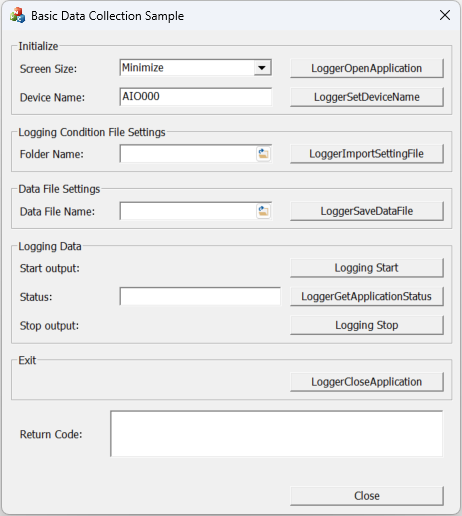

This is a sample client application that
starts C-LOGGER.
When learning how to use the C-LOGGER SDK, we recommend that you read this
sample first.
Before running this sample, make the following preparations.
A support
device must be installed in the Windows OS in advance.
If you do not have a support
device at hand, you can register the "AIO Demo Device" in
Windows OS to check the operation of the C-LOGGER.
For how to install the "AIO Demo Device," refer to API-TOOL(WDM)
Help "Home > Setup Driver Environment > Installing Hardware
Device > Install DEMO DEVICE ".
In addition, make device settings and channel
settings on the C-LOGGER, and confirm that data can be input from the
device.
When the device is operating normally, save the collection conditions to
a file on a local drive.
1. Initialize
- When you execute the sample program,
the main screen appears.
Specify the start size of C-LOGGER in screen. (Minimize, Normal,
Maximize)
- Click the [LoggerOpenApplication]
button to execute C-LOGGER.
If C-LOGGER does not execute, C-LOGGER may not be installed
properly.
Please refer "Uninstallation
for Application" and "Installation
for Application" topics.
- If you do not change "Device Name" specified on the C-LOGGER, you do not have to click the [LoggerSetDeviceName] button.
2. Logging Condition File Setting
- Specify the acquisition conditions file saved on the C-LOGGER.
There are two ways to specify the file name of the acquisition conditions.
First, enter the file name directly in "Folder Name:" field.
Second, there is an open
folder icon to the right of "Folder Name:" field.
Clicking this open folder icon allows you to browse files in
the local drive and select a specific an acquisition conditions file.
- After specifying the acquisition
conditions file name, click the [LoggerImportSettingFile] button to load
the collection conditions file.
And then, the acquisition conditions is applied to the C-LOGGER.
3. Logging Data
- Click the [Logging Start] button
in the main window to start data input from the specified device.
- Click the [Logging Stop] button in the main window to stop data input
from the specified device.
When the screen size of
the C-LOGGER is set to "Normal," the drawing on the C-LOGGER
is also updated in response to the instruction of [Logging Start]/[Logging
Stop].
For the drawing on the C-LOGGER, refer to Screen
Configuration of C-LOGGER.
- From the main screen, click the [LoggerGetApplicationStatus]
button to check the status of the specified device.
The operation status of the C-LOGGER can be checked even
if the screen size of the C-LOGGER is set to "Minimized."
4. Exit
- Click [LoggerCloseApplication] button
on the main screen to terminate C-LOGGER.
You can execute the OpenApplication function from another
client application.
- To access the data on C-LOGGER, press the [LoggerOpenApplication] button again.
5. Processing to terminate the program
- Press the [Close] button in the window to terminate your client program.